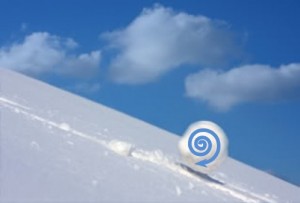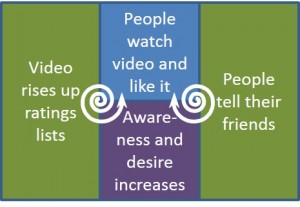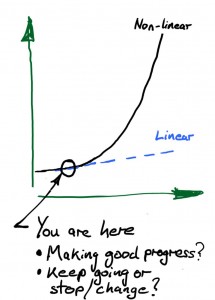The ‘Dancing Guy’ video below provides a clear and striking example of non-linear behaviour. While you are watching the video put yourself in the shoes of one of the observers. What would be your reactions? What sort of things would influence them? Would they change over time? What would it take to trigger you to join in?
Are there parallels here with change in organizations and in businesses? Perhaps the adoption of organizational change sometimes happens this way. Or possibly the video mirrors the progress of the introduction of a new product, or the introduction of an existing product into a new market.
For me, the video highlights a range of key observations about creating change in unpredictable and uncertain contexts:
- For the first third of the video all we see is one man and then a second dancing enthusiastically by themselves. But is this all that is happening? It is all we can see externally, but a lot is also happening in the brains of the observers. I suggest that many of them are starting to, consciously or subconsciously, think about what it would be like to join in. They are weighing the fun and exhilaration of dancing against the risk of standing out and potentially appearing silly. In a sense, the observers are progressively being ‘primed’ to join in. So, in our change initiatives, we should not just rely on our external observations to monitor progress. There is likely to be much happening below the surface.
- What would have happened if the ‘dancing guy’ had stopped just before the first person joined him? Would that second person have still got up and danced, this time by himself? Would a cascade still have happened? I think not? This suggests to me that in complex change perseverance is critical. If we are convinced that the change is important and valuable, we need to continue to, metaphorically, ‘dance and wave our arms’ to ensure that we are noticed and our message is heard.
- If creating a dancing crowd was his objective, considerable effort was expended by the ‘dancing man’ before he saw any return for it. When he did start to get a return for his effort, he achieved a very large return for little additional effort. A traditional benefit-cost review at any time during the first minute would have suggested that he ‘cut his losses’ and stop dancing.
- Would the ‘dancing man’ have attracted the same attention and had the same impact if he was not dancing so extravagantly and enthusiastically and so obviously enjoying himself? I think not. Sometimes, if we want to create change in uncertain and unpredictable situations, we need to be extravagant and enthusiastic to rise above the noise and the fear. This creates risks, because the crowd might not join us, but they are much more likely not to join us if we don’t take that risk.
- Would there have been the same impact if a small group of people, say six, had started dancing together in the same way? I am not sure. From one perspective, I think group may have been perceived as a clique and it would have been more difficult for the first additional person to join in. On the other hand, the risk of standing out would have been reduced for the first additional person. I think there is a lesson here when we start a change initiative with a pilot, especially if the pilot is in a distinct and very coherent area or group.
Perhaps the ‘Dancing Guy’ video triggers other thoughts and perspectives for you. If so, please respond with a comment.




 Why is non-linear behaviour so interesting and important? Because it is helps explain why certain situations change so rapidly and unpredictably. What might appear to be just small inconsequential changes or random ‘noise’ may in fact be the early weak signs of success (or failure). We may think that our new initiative is not working and prematurely abandon or significantly change it. Alternatively, we may see quick success and commit further resources to an initiative or change effort only to find that it expectedly slows down or stagnates. A deeper awareness of the nature and types of non-linear behaviour will sensitise us to the potential for these types of situations and help us look for indicators of non-linear patterns and mechanisms. It will also help us set expectations accordingly.
Why is non-linear behaviour so interesting and important? Because it is helps explain why certain situations change so rapidly and unpredictably. What might appear to be just small inconsequential changes or random ‘noise’ may in fact be the early weak signs of success (or failure). We may think that our new initiative is not working and prematurely abandon or significantly change it. Alternatively, we may see quick success and commit further resources to an initiative or change effort only to find that it expectedly slows down or stagnates. A deeper awareness of the nature and types of non-linear behaviour will sensitise us to the potential for these types of situations and help us look for indicators of non-linear patterns and mechanisms. It will also help us set expectations accordingly.
Follow Us!